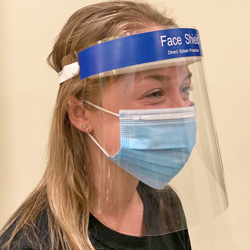Monona
– every wastewater treatment plant in the country that discharges
to a
body of water after treatment has to have a NPDES permit. While there is
no
universal requirement for individual permits from dischargers (limits on
what
you discharge to the system) within the Clean Water Act requirements,
there are
national limits on some things – you can follow this link to the
list - http://ecfr.gpoaccess.gov/cgi/t/text/t
ext-idx?c=ecfr&sid=ef332aa37d8c6324385f34859726d7c2&rgn=div
8&view=text&node=40:28.0.1.1.4.0.1.5&idno=40
What’s
interesting is that POTWs are REQUIRED to develop pre-treatment
standards. In
other words, they pretty much need to publish / provide discharge limits
(40CFR
403.5(c):
“Each
POTW developing a POTW Pretreatment Program pursuant to =A7403.8 shall
develop
and enforce specific limits to implement the prohibitions listed in
paragraphs
(a)(1) and (b) of this section. Each POTW with an approved pretreatment
program
shall continue to develop these limits as necessary and effectively
enforce
such limits.”
I
suspect the POTWs you are dealing with are in rural Virginia, and that
they are
either not aware of the requirements or assume a university won’t
generate prohibited wastewaters. If I were you, I’d develop your
own
internal limits based on the NPDES limits. You should still try to get
the
discharge limits from the POTW though…
Russ<
/span>
Russ
Phifer
WC
Environmental, LLC
1085C
Andrew Drive
West
Chester, PA=A0 19380
610-696-9220x12/
fax 610-344-7519
rphifer**At_Symbol_Here**wcenvironmental.com<
/p>
For the best
Online OSHA
& DOT Courses,
visit
http://wcenvironmental.advanceonline.com !
P
Please
consider your environmental responsibility before printing this e-mail
or any
other document
From:
DCHAS-L
Discussion
List [mailto:DCHAS-L**At_Symbol_Here**LIST.UVM.EDU] On Behalf Of
ACTSNYC**At_Symbol_Here**CS.COM
Sent: Tuesday, June 22, 2010 9:09 AM
To: DCHAS-L**At_Symbol_Here**LIST.UVM.EDU
Subject: Re: [DCHAS-L] help needed with water discharge
limits
All,
I need advice. As some of you know, the "laboratories" I
deal
with come under EPA's definition of laboratory for the new Subpart K
which
includes "art studios." But we use a lot of the same
solvents,
acids, metal compounds, etc., as you do.
I do building planning. Among my practices is to obtain from the
local
waste water treatment plant 1) the limits for solvents, grease, pH, and
various
metal ions for the school's effluent (or the plant's influent) and 2)
the
discharge limits for local storm sewers if we have basement ceramics,
sculpture, or other studios with storm drain access.
This usually is easy. Some Texas universities have the limits on their
EH&S
websites. Large cities often have municipal or state (if they are
state
colleges) websites they can direct me to. Small city plants
usually send
them to me by e-mail. Some colleges have especially low limits because
their
plants discharge to protected waterways. Others have very high
limits
because they go to massive big-city plants.
However, I planned one building in Virginia and the plant in this city
told me
they don't have any limits. They said people at the college can
put what
ever they want into drains! I figured they were wrong and
used
common sense limits to guide me so that the photography department would
install a silver recovery unit, flammable solvents would never go down
the drains,
and so on.
Now I've got another college building in a different city in
Virginia.
The school's EH Consultant contacted the local DEQ and plant for
me. She
was told they never monitor what comes out of the school and have no
limits for
them. So her advice to her people is we spend nothing from the
budget on
systems to protect water discharges!
It is really possible that in Virginia we can just dump our lead,
cadmium,
mercury, and chromium soluble pigments, our flammable solvents, etching
acids,
cyanide compounds, silver ion, etc., in the drains? If
that's the
case, can they deal with sweepings and mop water from the ceramic glaze
room
floor by dumping it in the sink? A school in Maine was cited by
EPA for
that because glaze waste won't pass a TCLP. And does that mean
that
college chemistry labs in Virginia also have no limits on what goes down
their
drains?
Surely something is wrong here. Can anyone help?
Monona Rossol
